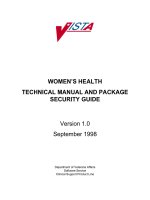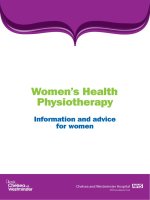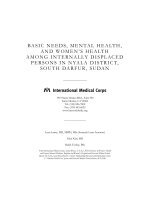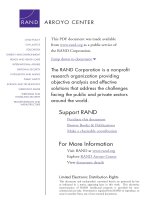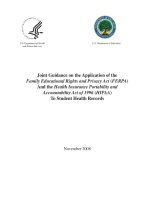China’s Health Insurance Reform And Disparities In Healthcare Utilizatio And Costs A Long Gitudinal Analysis
Bạn đang xem bản rút gọn của tài liệu. Xem và tải ngay bản đầy đủ của tài liệu tại đây (1.09 MB, 164 trang )
CHILDREN AND FAMILIES
EDUCATION AND THE ARTS
The RAND Corporation is a nonprofit institution that helps improve policy and
decisionmaking through research and analysis.
ENERGY AND ENVIRONMENT
HEALTH AND HEALTH CARE
INFRASTRUCTURE AND
TRANSPORTATION
This electronic document was made available from www.rand.org as a public service
of the RAND Corporation.
INTERNATIONAL AFFAIRS
LAW AND BUSINESS
Skip all front matter: Jump to Page 16
NATIONAL SECURITY
POPULATION AND AGING
PUBLIC SAFETY
SCIENCE AND TECHNOLOGY
TERRORISM AND
HOMELAND SECURITY
Support RAND
Browse Reports & Bookstore
Make a charitable contribution
For More Information
Visit RAND at www.rand.org
Explore the Pardee RAND Graduate School
View document details
Limited Electronic Distribution Rights
This document and trademark(s) contained herein are protected by law as indicated in a notice appearing
later in this work. This electronic representation of RAND intellectual property is provided for noncommercial use only. Unauthorized posting of RAND electronic documents to a non-RAND website is
prohibited. RAND electronic documents are protected under copyright law. Permission is required from
RAND to reproduce, or reuse in another form, any of our research documents for commercial use. For
information on reprint and linking permissions, please see RAND Permissions.
This product is part of the Pardee RAND Graduate School (PRGS) dissertation series.
PRGS dissertations are produced by graduate fellows of the Pardee RAND Graduate
School, the world’s leading producer of Ph.D.’s in policy analysis. The dissertation has
been supervised, reviewed, and approved by the graduate fellow’s faculty committee.
Dissertation
China’s Health Insurance
Reform and Disparities
in Healthcare Utilization
and Costs
A Longitudinal Analysis
Henu Zhao
C O R P O R AT I O N
Dissertation
China’s Health Insurance
Reform and Disparities
in Healthcare Utilization
and Costs
A Longitudinal Analysis
Henu Zhao
This document was submitted as a dissertation in October 2014 in
partial fulfillment of the requirements of the doctoral degree in public
policy analysis at the Pardee RAND Graduate School. The faculty
committee that supervised and approved the dissertation consisted
of Hao Yu (Chair), Emmett Keeler, and Gema Zamarro.
PA R D E E R A N D GRADUATE SCHOOL
The Pardee RAND Graduate School dissertation series reproduces dissertations that
have been approved by the student’s dissertation committee.
The RAND Corporation is a nonprofit institution that helps improve policy and
decisionmaking through research and analysis. RAND’s publications do not necessarily
reflect the opinions of its research clients and sponsors.
R® is a registered trademark.
Permission is given to duplicate this document for personal use only, as long as it is unaltered
and complete. Copies may not be duplicated for commercial purposes. Unauthorized
posting of RAND documents to a non-RAND website is prohibited. RAND documents are
protected under copyright law. For information on reprint and linking permissions, please
visit the RAND permissions page ( />
Published 2015 by the RAND Corporation
1776 Main Street, P.O. Box 2138, Santa Monica, CA 90407-2138
1200 South Hayes Street, Arlington, VA 22202-5050
4570 Fifth Avenue, Suite 600, Pittsburgh, PA 15213-2665
RAND URL: />To order RAND documents or to obtain additional information, contact
Distribution Services: Telephone: (310) 451-7002;
Fax: (310) 451-6915; Email:
Table of Contents
Tables.........................................................................................................................................................v
Figures.....................................................................................................................................................ix
Abstract...................................................................................................................................................xi
Acknowledgements...........................................................................................................................xiii
Chapter1Introduction........................................................................................................................1
Chapter2Background.........................................................................................................................3
2.1HealthinsurancereforminChina........................................................................................................3
2.1.1Collapseofhealthinsuranceschemesinthe1970sand1980s......................................................4
2.1.2Earlyeffortsinthe1980sandearly1990s..............................................................................................5
2.1.3Healthinsurancereformsincethelate1990s........................................................................................6
2.1.4Healthcarereformafter2009........................................................................................................................9
2.2ThreeMajorHealthInsuranceSchemes.........................................................................................10
2.2.1TheBasicMedicalInsuranceforUrbanEmployees...........................................................................10
2.2.2TheBasicMedicalInsuranceforUrbanResidents..............................................................................11
2.2.3TheNewRuralCooperativeMedicalInsurance...................................................................................13
2.3TrendsandCurrentStatusofHealthcareDisparities................................................................13
Chapter3LiteratureReviewandStudyObjectives................................................................19
3.1ExistingResearch....................................................................................................................................19
3.1.1LiteratureonRural–UrbanDisparitiesinHealthcareUtilization.................................................19
3.1.2LiteratureonDisparitiesinOut‐of‐PocketExpenditureandHealthcareCosts......................21
3.1.3LiteratureonDisparitiesinHealthInsuranceCoverage..................................................................22
3.1.4MethodologicalIssues.....................................................................................................................................22
3.2GapintheExistingLiterature.............................................................................................................26
3.3ObjectivesandResearchQuestions..................................................................................................27
Chapter4StudyDesign.....................................................................................................................28
4.1Data..............................................................................................................................................................28
4.2StudyPeriods............................................................................................................................................30
4.3ConceptualModelandVariableSelection......................................................................................30
4.3.1DependentVariables.......................................................................................................................................31
4.3.2IndependentVariables...................................................................................................................................33
4.4AnalyticApproach..................................................................................................................................38
4.4.1Difference‐in‐DifferencesAnalysiswithMultipleGroupsandMultipleTimePeriods........38
4.4.2MultivariateRegressionfortheVariablesthatdonotmeettheAssumptionofParallel
Trends...............................................................................................................................................................................44
4.5Sensitivityanalysis.................................................................................................................................46
4.5.1ControllingforInsuranceStatus.................................................................................................................46
4.5.2DroppingtheRichestProvinceorthePoorestProvince..................................................................46
iii
4.5.3IncludingInteractionTermswithHouseholdIncome......................................................................47
4.5.4DIDAnalysisResultsforVariablesinWhichParallelTrendsdidnotHold..............................47
Chapter5Results:DisparitiesinHealthcareUtilization......................................................48
5.1DescriptiveAnalysis...............................................................................................................................48
5.2DIDAnalysisforFormalCareUtilizationandOutpatientUtilization..................................51
5.3MultivariateAnalysisControllingforExistingTrendsforInpatientUtilization.............57
5.4SensitivityAnalysis................................................................................................................................64
5.4.1ControllingforInsuranceStatus.................................................................................................................64
5.4.2DroppingtheRichestProvinceorthePoorestProvince..................................................................71
5.4.3IncludingInteractionTermswithHouseholdIncome......................................................................80
5.4.4DIDAnalysisforInpatientCare..................................................................................................................84
5.5SummaryofFindings.............................................................................................................................85
Chapter6Results:Disparitiesinhealthcarecosts..................................................................88
6.1DescriptiveAnalysis...............................................................................................................................88
6.2MultivariateAnalysisControllingforExistingTrends..............................................................91
6.3SensitivityAnalysis..............................................................................................................................103
6.3.1controllingforhealthinsurancestatus.................................................................................................103
6.3.2droppingtherichestprovinceorthepoorestprovince.................................................................107
6.3.3.Includinginteractiontermswithhouseholdincome.....................................................................116
6.3.4DIDanalysisresultsforcostvariables..................................................................................................131
6.4SummaryofFindings...........................................................................................................................133
Chapter7Conclusion,Discussion,andPolicyImplications..............................................135
7.1Conclusion...............................................................................................................................................135
7.2Discussion................................................................................................................................................137
7.2.1ComparingWiththePublishedResearch............................................................................................137
7.2.2Strengths...........................................................................................................................................................138
7.2.3Limitations........................................................................................................................................................139
7.2.4FutureDirections...........................................................................................................................................140
7.3PolicyImplications...............................................................................................................................140
Appendix.............................................................................................................................................143
Reference............................................................................................................................................145
iv
Tables
Table4.1SampleSizebyRuralandUrbanResidencesandRegistrations....................................................29
Table4.2DescriptiveStatisticsofIndependentVariablesbyRuralandUrbanResidencesand
Registrations..................................................................................................................................................................37
Table4.3ResultsofDIDAnalysisUsing1993and1997WavesforHealthcareUtilization...................42
Table4.4ResultsofDIDAnalysisUsing1993and1997WavesforHealthcareCosts.............................44
Table5.1DIDAnalysisResultsforFormalCareUtilizationandOutpatientUtilization..........................54
Table5.2TestResultsforDIDAnalysisofFormalCareUtilizationandOutpatientUtilization...........55
Table5.3MultivariateAnalysisResultsforInpatientCareUtilization..........................................................59
Table5.4TestResultsofDisparitiesforInpatientCareUtilization.................................................................60
Table5.5TestResultsofChangeinDisparitiesforInpatientCareUtilization............................................62
Table5.6DIDAnalysisResultsofFormalCareandOutpatientUtilization(ControllingforInsurance
Status)...............................................................................................................................................................................65
Table5.7TestResultsforDIDAnalysisofHealthcareUtilization(ControllingforInsuranceStatus)
.............................................................................................................................................................................................66
Table5.8MultivariateAnalysisResultsforInpatientCareUtilization(ControllingforInsurance
Status)...............................................................................................................................................................................67
Table5.9TestResultsofDisparitiesforInpatientCareUtilization(ControllingforInsuranceStatus)
.............................................................................................................................................................................................69
Table5.10TestResultsofChangeinDisparitiesforInpatientCareUtilization(Controllingfor
InsuranceStatus).........................................................................................................................................................70
Table5.11DIDAnalysisResultsforFormalCareandOutpatientUtilization(DroppingtheRichest
Province).........................................................................................................................................................................73
Table5.12TestResultsforFormalCareandOutpatientUtilization(DroppingtheRichestProvince)
.............................................................................................................................................................................................74
Table5.13DIDAnalysisResultsforFormalCareandOutpatientUtilization(DroppingthePoorest
Province).........................................................................................................................................................................75
Table5.14TestResultsforFormalCareandOutpatientUtilization(DroppingthePoorestProvince)
.............................................................................................................................................................................................76
v
Table5.15MultivariateAnalysisResultsforInpatientUtilization(DroppingtheRichest/Poorest
Province).........................................................................................................................................................................77
Table5.16TestResultsofDisparitiesinInpatientUtilization(DroppingtheRichest/poorest
Province).........................................................................................................................................................................78
Table5.17TestResultsofChangeinDisparitiesforInpatientCareUtilization(Droppingthe
Richest/poorestProvince).......................................................................................................................................79
Table5.18DIDAnalysisResultsforFormalCareandOutpatientUtilizations(IncludingInteraction
TermwithHouseholdIncome)..............................................................................................................................82
Table5.19TestResultsforFormalCareandOutpatientUtilizations(IncludingInteractionTerm
withHouseholdIncome)..........................................................................................................................................83
Table5.20DIDAnalysisResultsforInpatientCareUtilization..........................................................................84
Table5.21TestResultsforInpatientCareUtilization(DIDAnalysis)............................................................85
Table6.1MultivariateAnalysisResultsforOOPExceedingCertainPercentageofHouseholdIncome
.............................................................................................................................................................................................93
Table6.2MultivariateAnalysisResultsforTotalHealthcareCosts.................................................................95
Table6.3TestResultsofDisparitiesforOOPExceedingCertainPercentageofHouseholdIncome
..........................................................................................................................................................................................100
Table6.4TestResultsofChangesinDisparitiesforOOPExceedingCertainPercentageofHousehold
Income...........................................................................................................................................................................101
Table6.5BootstrapResultsforDisparitiesinTotalHealthCosts.................................................................103
Table6.6Multi‐variateAnalysisResultsforOOPExceedingCertainPercentageofHousehold
Income(ControllingforInsurance)..................................................................................................................104
Table6.7TestResultsofDisparitiesforOOPExceedingCertainPercentageofHouseholdIncome
(ControllingforInsurance)...................................................................................................................................105
Table6.8TestResultsofChangesinDisparitiesforOOPExceedingCertainPercentageofHousehold
Income(ControllingforInsurance)..................................................................................................................106
Table6.9BootstrapResultsforDisparitiesinTotalHealthCost(ControllingforInsurance)...........107
Table6.10Multi‐variateAnalysisResultsforOOPExceedingCertainPercentageofHousehold
Income(DroppingtheRichestProvince).......................................................................................................109
Table6.11TestResultsofDisparitiesforOOPExceedingCertainPercentageofHouseholdIncome
(DroppingtheRichestProvince)........................................................................................................................110
vi
Table6.12TestResultsofChangesinDisparitiesforOOPExceedingCertainPercentageof
HouseholdIncome(DroppingtheRichestProvince)................................................................................111
Table6.13Multi‐variateAnalysisResultsforOOPExceedingCertainPercentageofHousehold
Income(DroppingthePoorestProvince).......................................................................................................112
Table6.14TestResultsofDisparitiesforOOPExceedingCertainPercentageofHouseholdIncome
(DroppingthePoorestProvince).......................................................................................................................113
Table6.15TestResultsofChangesinDisparitiesforOOPExceedingCertainPercentageof
HouseholdIncome(DroppingthePoorestProvince)...............................................................................114
Table6.16BootstrapResultsforDisparitiesinTotalHealthCosts(DroppingtheRichestProvince)
..........................................................................................................................................................................................115
Table6.17BootstrapResultsforDisparitiesinTotalHealthCost(DroppingthePoorestProvince)
..........................................................................................................................................................................................116
Table6.18Multi‐variateAnalysisResultsforOOPExceedingCertainPercentageofHousehold
Income(Low‐incomeFamilies)..........................................................................................................................118
Table6.19TestResultsofDisparitiesforOOPExceedingCertainPercentageofHouseholdIncome
(Low‐incomeFamilies)...........................................................................................................................................119
Table6.20TestResultsofChangesinDisparitiesforOOPExceedingCertainPercentageof
HouseholdIncome(Low‐incomeFamilies)...................................................................................................120
Table6.21Multi‐variateAnalysisResultsforOOPExceedingCertainPercentageofHousehold
Income(Medium‐incomeFamilies)..................................................................................................................122
Table6.22TestResultsofDisparitiesforOOPExceedingCertainPercentageofHouseholdIncome
(Medium‐incomeFamilies)..................................................................................................................................123
Table6.23TestResultsofChangesinDisparitiesforOOPExceedingCertainPercentageof
HouseholdIncome(Medium‐incomeFamilies)...........................................................................................124
Table6.24Multi‐variateAnalysisResultsforOOPExceedingCertainPercentageofHousehold
Income(High‐incomeFamilies).........................................................................................................................126
Table6.25TestResultsofDisparitiesforOOPExceedingCertainPercentageofHouseholdIncome
(High‐incomeFamilies)..........................................................................................................................................127
Table6.26TestResultsofChangesinDisparitiesforOOPExceedingCertainPercentageof
HouseholdIncome(High‐incomeFamilies)..................................................................................................128
Table6.27BootstrapResultsforDisparitiesinTotalHealthCosts(Low‐incomeFamilies)..............129
Table6.28BootstrapResultsforDisparitiesinTotalHealthCosts(Medium‐incomeFamilies)......130
vii
Table6.29BootstrapResultsforDisparitiesinTotalHealthCosts(High‐incomeFamilies).............130
Table6.30DIDAnalysisResultsforOOPExceedingCertainPercentageofHouseholdIncome.......132
Table6.31TestResultsforOOPExceedingCertainPercentageofHouseholdIncome(DIDAnalysis)
..........................................................................................................................................................................................132
Table6.32BootstrapResultsforDisparitiesinTotalHealthCosts(DIDAnalysis)...............................133
viii
Figures
Figure2.1HealthInsuranceCoverageinUrbanandRuralAreasinChina,SelectedYears1993‐2008
.............................................................................................................................................................................................15
Figure2.2HealthServiceUtilizationinUrbanandRuralAreasinChina(2003)......................................16
Figure2.3HealthcareSpendinginChina,bySourceandYear...........................................................................17
Figure2.4PerCapitaOut‐of‐PocketHealthExpensesasaPercentageofIncome.....................................18
Figure4.1UpdatedStructureofAndersonModel...................................................................................................31
Figure5.1ProbabilityofFormalCareUtilizationin4WeeksbyRuralandUrbanResidencesand
Registrations..................................................................................................................................................................48
Figure5.2ProbabilityofOutpatientCareUtilizationin4WeeksbyRuralandUrbanResidencesand
Registrations..................................................................................................................................................................49
Figure5.3ProbabilityofInpatientCareUtilizationin4WeeksbyRuralandUrbanResidencesand
Registrations..................................................................................................................................................................50
Figure5.4PredictedProbabilityofFormalCareUtilizationin4WeeksbyRuralandUrban
ResidencesandRegistrations.................................................................................................................................56
Figure5.5PredictedProbabilityofOutpatientCareUtilizationin4WeeksbyRuralandUrban
ResidencesandRegistrations.................................................................................................................................57
Figure5.6PredictedProbabilityofInpatientCareUtilizationin4WeeksbyRuralandUrban
ResidencesandRegistrations.................................................................................................................................63
Figure6.1ProbabilityofHavingOut‐of‐pocketMedicalExpenseExceeding20%ofHousehold
IncomebyRuralandUrbanResidencesandRegistrations.......................................................................89
Figure6.2ProbabilityofHavingOut‐of‐pocketMedicalExpenseExceeding40%HouseholdIncome
byRuralorUrbanResidencesandRegistrations...........................................................................................90
Figure6.3TotalHealthcareCostsbyRuralandUrbanResidencesandRegistrations............................91
Figure6.4PredictedProbabilityofHavingOOPExceeding20%ofHouseholdIncomebyRuraland
UrbanResidencesandRegistrations...................................................................................................................97
Figure6.5PredictedProbabilityofHavingOOPExceeding40%ofHouseholdIncomebyRuraland
UrbanResidencesandRegistrations...................................................................................................................98
Figure6.6PredictedTotalHealthcareCostsbyRuralandUrbanResidencesandRegistrations.......98
ix
Abstract
China’seconomicsuccessduringthepast30yearswasnotmirroredinitshealth
caresystem.Asaresult,therural‐urbandisparitiesinhealthinsurancecoverageandthe
relatedhealthcareareasbecameprominent.Sincethelate1990s,Chinahasbeen
expandinginsurancecoverage,inordertoprovideaccessibleandaffordablehealthcareto
allresidents.Mystudyanalyzeswhethertheinsuranceexpansionreducesrural‐urban
disparitiesintermsofhealthcareutilizationandfinancialprotection.Tomyknowledge,
thisisthefirststudytoaddressthedisparityissuebyexaminingChina’shealthcarereform
policiesoveranextended18‐yearperiod(1993‐2011).Itisalsothefirststudytoaddress
thedynamicphenomenonofrural‐urbanmigrationduringthestudyperiodbyseparating
thestudygroupinto4subgroupsintermsofrespondentsinresidentialareasversus
householdregistrationtype.
DrawingonsevenwavesofdatafromtheChinaHealthandNutritionSurveyand
applyingmultivariateanalysistechniques,suchasdifference‐in‐differenceanalysisand
generalizedlinearmodel,Ifindthatrural‐urbandisparitiesinformalcareandoutpatient
utilizationweresignificantlyreducedbytheexpandedhealthinsurancecoverageinrural
areain2003.Therural‐urbandisparityintotalhealthcostsisalsosignificantlyreduced.
However,noevidenceshowsthatthepolicychangesinhealthinsurancecoveragehad
impactondisparitiesininpatientutilizationorhavinghighout‐of‐pocketpayments.By
conductingseveralsetsofsensitivityanalyses,mystudyalsofindsthattheexpanded
healthinsurancecoverageimpactedricherprovincemorethanpoorerprovinces,and
impacthigh‐incomefamiliesmorethanmedium‐andlow‐incomefamilies.
xi
ThestudyfindingshaveimportantpolicyimplicationsforChina’songoinghealth
carereform.First,China’spolicymakersshouldprovidebetterhealthcarecoverageand
morehealthcareresourcestoruralareastofurtherreducetherural‐urbandisparity.
Second,sincepriorpolicychangesaffectedrichprovincemorethanpoorprovince,new
policyshouldtargetspecificallypoorprovinces.Third,giventhefindingthatthepositive
impactonhealthcareutilizationofpolicychangein2003happeningmainlyinhigh‐income
groups,newpolicychangeshouldfocusmoreonmedium‐andlow‐incomegroup.
xii
Acknowledgements
Iamgratefulforthesupportprovidedbymywonderfuldissertationcommittee:Dr.
HaoYu,Dr.GemaZamarro,andDr.EmmettKeeler.Thesuccessfulcompletionofthis
dissertationwasaconsequenceoftheirexcellentguidance.Iamespeciallythankfulfor
mentorshipofmyCommitteeChair,Hao.Histimelyfeedbacksonourweeklymeetings
werecrucialtokeepmeontherighttrack.IwouldalsoliketothankGemaandEmmettfor
theirinsightfulandconstructiveadvicesonthepolicycontextandmethodologicalissues.I
alsowanttothankmyoutsidereaderTeh‐weiHu,ProfessorEmeritusofHealthEconomics,
UniversityofCalifornia,Berkeley,forhishelpfulandresponsivecommentsonmy
dissertation.
IwouldalsoliketothankmyresearchmentorNelsonLim.Hetaughtmehowtodo
researchandhowtowrite,andprovidedmewithadvicesandencouragementduringmy
dissertationwork.IwouldalsoliketothankthePRGSfaculty,staffandstudentsfortheir
helpduringmydissertationwriting.
Thedissertationwouldnothavebeenpossiblewithoutthegenerousfinancial
supportprovidedbytheRosenfeldDissertationAward.
Lastly,Iwouldliketoextendspecialthankstomyparentsfortheirtrustand
encouragement,andtomyhusband,YongFu,forhisloveandsupport.
xiii
Chapter 1 Introduction
Chinaexperiencedrapideconomicgrowthinthepasttwodecades,benefitingmany
sectorsoftheeconomy.However,theeconomicsuccesswasnotmirroredinthehealthcare
system.Instead,thetransitionfromacentrallyplannedeconomytoamarket‐oriented
economyhascausedproblemsinthepublichealtharena.Forexample,aftertheeconomic
reformsstartedin1978,theexistinghealthinsuranceprovidersfacedincreased
operationalchallenges,andasaresult,manyresidentslackedanyformofhealthinsurance.
Theconditionwasespeciallytroublesomeinruralareas,revealingsharprural‐urban
disparitiesinhealthinsurancecoverageandrelatedhealthcareservicesandcosts.Since
thelate1990s,therehavebeenattemptstoexpandpublichealthinsurancecoverageto
bothruralandurbanresidentsinordertoprovideaccessibleandaffordablehealthcareto
allresidents.Anothergoalofthehealthcarereformswastoprovidehealthcaretothepoor
anddisadvantagedpopulations.Asoftheendof2011,threehealthinsuranceprograms,
calledschemes,wereestablished,coveringmostoftheruralandurbanresidentswith
someformofhealthinsurance.However,theperformanceofthecurrenthealthinsurance
schemeshasnotbeenwellexamined.Mixedfindingshavebeenpresentedregardingthis
issue.Mydissertationfocusesontheroleofhealthinsuranceinreducingtherural‐urban
disparitiesintermsofhealthcareutilizationandfinancialprotection,inthecontextofthe
currenthealthinsuranceschemes.
Thedissertationisorganizedasfollows:Chapter2providesthebackgroundofthe
policychange.ThechapterbrieflyreviewsthehistoryoftheChinesehealthinsurance
systemreform,includingthecollapseandre‐establishmentofthesystems.Ialsoprovide
1
statisticsofthetrendsandcurrentstatusofrural‐urbanhealthcaredisparities.Chapter3
reviewsexistingliteratureonthetopicofrural‐urbanhealthcaredisparitiesand
summarizestheresearchquestions.Chapter4presentsthestudydesign,includingdata
used,conceptualframework,andanalyticalapproach.Chapters5and6presenttheresults
ofthestudy.InChapter7,Iconcludethestudyandpresentpolicyimplications.
2
Chapter 2 Background
ThegreateconomicreforminChinabroughtchangestoallareasoftheeconomy,
includingthehealthcaresystem.Unfortunately,asaresult,manyresidentslosthealth
insurancecoverage.Theexistinghealthinsuranceschemesexperienceddifficultiesin
providingsufficienthealthcaretoinsuredresidents.Thecooperativemedicalscheme(CMS)
providingruralhealthinsuranceexperiencedthegreatestdamage.Inresponsetothe
emergingproblemsinitshealthcaresystem,Chinahasmadenumerousattemptstorebuild
universalcoveragesystemsincethelate1990s.Throughdecadesofeffort,theChinese
governmenthasdevelopedthreesystems,inbothurbanandruralareas,whichprovide
coverageformorethan90%ofthepopulation.Duringthelaunchofeachnewhealth
insurancescheme,thegovernmentalsoproposedothermeasurestoprovidemore
healthcareresourcestothetargetedpopulation.Thesemeasuresworktogetherwiththe
healthinsurancesystemstoprovidesufficientandaffordablehealthcaretoallresidents.
Althoughtherehasbeengreatprogress,thehealthinsurancesystemisfarfromperfect.
Thehealthinsurancereformisstillunderway,andtheeffectoftheexpandedinsurance
coverageinChinaisstillunderdebate.
2.1 Health insurance reform in China
Inthissection,IreviewthehistoryofhealthinsurancereforminChina.Thehealth
insurancesystemcollapsedinthelate1970s,andagreatnumberofresidentsleft
uninsured.Startingfromthelate1990s,thegovernmentestablishedthreenewhealth
insurancesystemsinbothruralandurbanareas.In2009,thegovernmentstartedanew
roundofhealthcarereform.Inthenewroundofreform,themajorgoalwastoprovide
3
universalcoveragetoallresidents,andtotargetondisadvantagepopulationtoimprove
thehealthcareserviceforthemandreducedisparities.
2.1.1Collapseofhealthinsuranceschemesinthe1970sand1980s
Sincethelate1970s,theChineseeconomicreformshaveledtoaperiodof
prosperity.However,theeconomicsuccesswasnotmirroredinthehealthcaresystem.
Instead,theeconomictransitioncausedproblemsinthepublichealtharena.
Priortotheeconomicreforms,therewerethreebasicformsofinsurance,which
coveredalmostallChinesecitizens.TheGovernmentInsuranceScheme(GIS)covered
governmentemployees.TheLaborInsuranceScheme(LIS)coveredstate‐ownedenterprise
(SOE)workers.Finally,thecooperativemedicalscheme(CMS)coveredtherural
agriculturalworkers.Theeconomicreformsbroughtchangestothehealthcaresector,
weakeningallthreeformsofinsurancetosomeextent.First,thegovernment‐runhospitals
undertheGISexperiencedfinancialdifficultiesandthuswerehardpressedtoprovide
sufficienthealthcareservicetothoseinsuredunderGIS.Onereasonforthefinancialcrisis
wasthattheeconomicreformsledtorelaxationofpricecontrols,andasaresult,thecosts
incurredbythegovernment‐runhospitalsincreased.Anotherreasonisthatthe
governmentcontributedlesstopublichospitals:Governmentcontributionsshrankfrom50%
inthe1980stolessthan10%in2000(Wang2004).Second,duringthereform,financial
autonomywasgrantedtotheSOEs.Asaresult,alargenumberofSOEsclosed,andmany
employeeslosttheirjobs.Thus,thenumberofthoseinsuredbytheLISwasreduced.Even
thosewhokepttheirjobsfoundthattheirSOEemployersfaceddifficultiesinfinancing
healthinsuranceforworkers(Li2008).Finally,intheruralareas,thebasicproductionunit
4
becamehouseholdsasthecollectivefarmsweredismantled.TheCMSalsocollapsedwith
thischange.Inthe1990s,thevastmajorityoftheruralpopulationlackedanyformof
healthinsurancecoverage(Hsiao1984;Liu2004).
Asmentioned,allthreemajorhealthinsurancesystemsexperienceddamagesasa
resultofthechangesbroughtbytheeconomicreforms,andamongthem,theruralhealth
insuranceschemeCMSfacedthebiggestchallenge.By1998,thepercentageofrural
residentswithanyformofhealthinsurancecoveragehaddroppedto13%,comparedto56%
forresidentscoveredinurbanareas(ChinaMinistryofHealth,2004).Astheurban‐rural
gapwidened,theurban‐ruraldisparityinhealthinsurancestartedtodrawmoreattention.
2.1.2Earlyeffortsinthe1980sandearly1990s
Beforethemajorhealthreformsbeganinthelate1990s,therehadbeenattemptsto
improvetheexistinghealthinsurancesystems.Evensincethe1980s,actionshadbeen
takeninurbanareastorelievethefinancialburdenonthehealthinsurancesystems.By
introducingdemand‐andsupply‐sidecostsharing,theattemptsinthe1980sfocusedon
reducingcosts.Theseactionscurbedtherapidhealthcarecostgrowth,buttheywerenot
abletosolvethefundamentalfinancialproblems(Liu2002).Beginningintheearly1990s,
thegovernmentintroducedmoreactionstoincreasethelevelofriskpooling.In1995,the
governmentintroducedanewmodelcombiningindividualresponsibilityandsocial
protectionwithcity‐wideriskpooling.However,pilotprogramsofthenewsystemwere
launchedinonlytwocitiesandwerenotspreadnationwideuntilthelate1990s.
Inruralareas,debateandresearchhasfocusedonhowtomaintainthecollapsing
corporativeinsuranceschemefromthe1980sand1990s.Thecentralgovernment’seffort
5
mainlyfocusedonurbanarea;thelocalgovernmentswereadvisedtodevelopand
completethecurrentCMSsystemsbasedonlocaleconomicconditions.However,thelocal
actionsonlyslightlyincreasedthehealthinsurancecoverageinruralareas.Mostofthe
coverageconcentratedonlyondevelopedprovincesandcities,suchasShanghai,Jiangsu,
Guangdong,andShandong.Bytheendof1990s,mostoftheruralresidentswereleft
uninsured.
2.1.3Healthinsurancereformsincethelate1990s
Inresponsetotheemergingproblemsinitshealthcaresystem,Chinahasmade
numerousattemptstorebuilduniversalcoveragesincethelate1990s.Thegoalof
universalcoverageistoprovidesafe,effective,convenient,andaffordablebasicmedical
servicestoallurbanandruralresidents(StateCouncil,2009).Oneofthemostimportant
componentsofuniversalcoverageishealthinsurance.Beforethisgoalofuniversal
coveragewasofficiallyintroducedin2009withtheChinesegovernment’sannouncement
oftheblueprintforhealthsystemreform,healthinsurancereformsinbothurbanandrural
areashadresultedingreaterhealthinsurancecoverage.Threemajorhealthinsurance
schemeswereestablished.TheUrbanEmployeesBasicMedicalInsurancewaslaunchedin
urbanareasin1998,andtheUrbanResidentsBasicMedicalInsurancewaslaunchedin
2007.Inruralareas,theNewRuralCooperativeMedicalInsurance(NRCM)was
establishedin2003.In2008,thetwourbanhealthinsuranceschemescoveredabout65%
ofurbanresidents,andtheruralschemecoveredabout90%ofruralresidents(National
HealthServicesSurvey,2008).Thethreemajorhealthinsuranceschemesarediscussedin
detailinthenextsection.
6
Theexpandedhealthinsurancecoverageprovidedresidentswithmorefinancial
protectionandencouragedresidentstousehealthcarewhenneeded.However,the
utilizationofhealthcarewasalsosubjectedtomedicalresourcesavailable.Insteadofonly
providinghealthinsurancecoveragetoresidents,thehealthcarereformwasa
comprehensivesystemwithothermeasuresandactions.Thesemeasuresandactions
workedtogetherwithhealthinsuranceexpansion,providingresidentswithmore
healthcareresourcesandgrantingthemadequatehealthcareaccess.
First,themedicalservicesystemwithbasicfacilitieswasconstructedinruralareas.
In2003,togetherwiththelaunchofNRCM,theStateCouncilannouncedothermeasures
designedtorebuildtheruralmedicalsystem(StateCouncil,2002).Oneofthemeasures
wastoconstructthemedicalservicesystemwithbasicfacilities.Inordertoachievethis
goal,centralandlocalgovernmentsincreasedtheirfinancialsupporttothemedicalsystem
eachyear.From2003to2010,theincreasedfundingwaspartiallyusedontheconstruction
ofthemedicalsystem.Localgovernmentsatthecountylevelwereresponsibleforthe
operationalcostofthelocalmedicalfacilities.Thecentralgovernmentandlocal
governmentsattheprovincelevelprovidedundevelopedareaswithsubsidiesfor
infrastructureconstruction.
Second,amedicalassistanceprogramwasestablishedinbothruralandurbanareas.
Inruralareas,theprogramwaslaunchedin2003.Theprogramwastoprovidefinancial
assistancetolow‐incomehouseholds.Theassistancecouldeitherbeusedtotreat
catastrophicdiseaseorbeusedaspremiumstojointhelocalNRCM.Governmentsubsidies
fortheprogramhavebeenincreasingsincetheprogramwaslaunched.Inurbanareas,the
7
programwaslaunchedin2005.Thetargetedpopulationswere(a)urbanresidentsliving
belowthepovertylinewhodidnotjointheUrbanResidentsBasicMedicalInsurance;and
(b)urbanresidentswhojoinedtheURBMIbutwerestillcarryingheavyfinancialburdens.
Theprogramwasdesignedandfundedbylocalgovernments.Thecentralgovernmentalso
providedassistancethroughgovernmenttransfers.
Third,trainingofmedicalprofessionalswasenhancedinruralareas.Inits2002
documentNo.13,theStateCouncilannouncedmeasurestoimprovethequalityofmedical
professionalsinruralareas.Inpost‐secondarymedicalschools,theCouncilintroduceda5‐
yearprogramaftermiddleschoolanda3‐yearprogramafterhighschool,inaneffortto
producemoremedicalprofessionals,especiallyforruralareas.Medicalgraduatesand
retiredmedicalprofessionalsfromurbanareaswereencouragedtogobacktoworkin
ruralareas(StateCouncil,2002).Asareflectionofongoingprogress,measurestoimprove
educationandtrainingofmedicalprofessionalwereintroducedagaininanewroundof
healthreform(StateCouncil,2009).Healthcareworkerswereencouragedtoattendformal
educationprogramsandobtainofficiallicenses.Thetrainingofgeneralpractitionersfor
ruralareaswasincludedintheMinistryofEducation2010workplan.Thegovernment
providedthetrainingcosts(MengandTang2010).
Finally,thegovernmentundertookotheractionstorefinethewholemedicalsystem,
suchasregulationofdrugpolicy,allocationofmedicalfunding,andstrengtheningof
administrationandsupervisionsystem.Allthemeasuresworkedasawholetoimprovethe
medicalserviceforbothruralandurbanareas.
8



